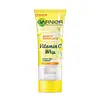What's inside
What's inside
 Key Ingredients
Key Ingredients

 Benefits
Benefits

 Concerns
Concerns

 Ingredients Side-by-side
Ingredients Side-by-side

Water
Skin ConditioningGlycerin
HumectantNiacinamide
SmoothingAlcohol
AntimicrobialDipropylene Glycol
HumectantDimethicone
EmollientButylene Glycol
HumectantPEG/PPG/Polybutylene Glycol-8/5/3 Glycerin
HumectantPEG-8
HumectantZea Mays Starch
AbsorbentLinalool
PerfumingCarbomer
Emulsion StabilisingGlycolic Acid
BufferingDimethiconol
EmollientParfum
MaskingSodium Hydroxide
BufferingSodium Citrate
BufferingSodium Hyaluronate
HumectantSodium Benzoate
MaskingPhenoxyethanol
PreservativeMannitol
HumectantPhenylethyl Resorcinol
AntioxidantAmmonium Polyacryloyldimethyl Taurate
Emulsion StabilisingAscorbyl Glucoside
AntioxidantTocopheryl Acetate
AntioxidantLimonene
PerfumingPaeonia Suffruticosa Root Extract
Skin ProtectingCaprylyl Glycol
EmollientMicrocrystalline Cellulose
AbsorbentCapryloyl Salicylic Acid
ExfoliatingTetrasodium EDTA
Hydrolyzed Lupine Protein
Skin ConditioningHexyl Cinnamal
PerfumingBenzyl Alcohol
PerfumingCI 16035
Cosmetic ColorantWater, Glycerin, Niacinamide, Alcohol, Dipropylene Glycol, Dimethicone, Butylene Glycol, PEG/PPG/Polybutylene Glycol-8/5/3 Glycerin, PEG-8, Zea Mays Starch, Linalool, Carbomer, Glycolic Acid, Dimethiconol, Parfum, Sodium Hydroxide, Sodium Citrate, Sodium Hyaluronate, Sodium Benzoate, Phenoxyethanol, Mannitol, Phenylethyl Resorcinol, Ammonium Polyacryloyldimethyl Taurate, Ascorbyl Glucoside, Tocopheryl Acetate, Limonene, Paeonia Suffruticosa Root Extract, Caprylyl Glycol, Microcrystalline Cellulose, Capryloyl Salicylic Acid, Tetrasodium EDTA, Hydrolyzed Lupine Protein, Hexyl Cinnamal, Benzyl Alcohol, CI 16035
 Reviews
Reviews

Ingredients Explained
These ingredients are found in both products.
Ingredients higher up in an ingredient list are typically present in a larger amount.
Linalool is a fragrance and helps add scent to products. It's derived from common plants such as cinnamon, mint, citrus, and lavender.
Like Limonene, this ingredient oxidizes when exposed to air. Oxidized linalool can cause allergies and skin sensitivity.
This ingredient has a scent that is floral, spicy tropical, and citrus-like.
Learn more about LinaloolParfum is a catch-all term for an ingredient or more that is used to give a scent to products.
Also called "fragrance", this ingredient can be a blend of hundreds of chemicals or plant oils. This means every product with "fragrance" or "parfum" in the ingredients list is a different mixture.
For instance, Habanolide is a proprietary trade name for a specific aroma chemical. When used as a fragrance ingredient in cosmetics, most aroma chemicals fall under the broad labeling category of “FRAGRANCE” or “PARFUM” according to EU and US regulations.
The term 'parfum' or 'fragrance' is not regulated in many countries. In many cases, it is up to the brand to define this term.
For instance, many brands choose to label themselves as "fragrance-free" because they are not using synthetic fragrances. However, their products may still contain ingredients such as essential oils that are considered a fragrance by INCI standards.
One example is Calendula flower extract. Calendula is an essential oil that still imparts a scent or 'fragrance'.
Depending on the blend, the ingredients in the mixture can cause allergies and sensitivities on the skin. Some ingredients that are known EU allergens include linalool and citronellol.
Parfum can also be used to mask or cover an unpleasant scent.
The bottom line is: not all fragrances/parfum/ingredients are created equally. If you are worried about fragrances, we recommend taking a closer look at an ingredient. And of course, we always recommend speaking with a professional.
Learn more about ParfumPhenoxyethanol is a preservative that has germicide, antimicrobial, and aromatic properties. Studies show that phenoxyethanol can prevent microbial growth. By itself, it has a scent that is similar to that of a rose.
It's often used in formulations along with Caprylyl Glycol to preserve the shelf life of products.
Sodium Benzoate is a preservative. It's used in both cosmetic and food products to inhibit the growth of mold and bacteria. It is typically produced synthetically.
Both the US FDA and EU Health Committee have approved the use of sodium benzoate. In the US, levels of 0.1% (of the total product) are allowed.
Sodium benzoate works as a preservative by inhibiting the growth of bacteria inside of cells. It prevents the cell from fermenting a type of sugar using an enzyme called phosphofructokinase.
It is the salt of benzoic acid. Foods containing sodium benzoate include soda, salad dressings, condiments, fruit juices, wines, and snack foods.
Studies for using ascorbic acid and sodium benzoate in cosmetics are lacking, especially in skincare routines with multiple steps.
We always recommend speaking with a professional, such as a dermatologist, if you have any concerns.
Learn more about Sodium BenzoateWater. It's the most common cosmetic ingredient of all. You'll usually see it at the top of ingredient lists, meaning that it makes up the largest part of the product.
So why is it so popular? Water most often acts as a solvent - this means that it helps dissolve other ingredients into the formulation.
You'll also recognize water as that liquid we all need to stay alive. If you see this, drink a glass of water. Stay hydrated!
Learn more about Water